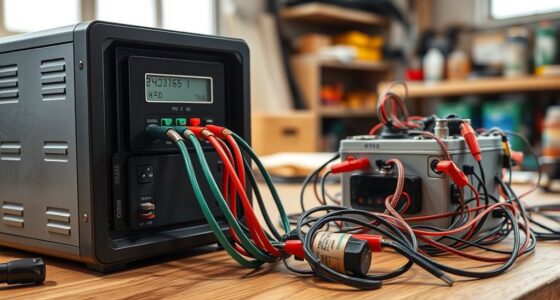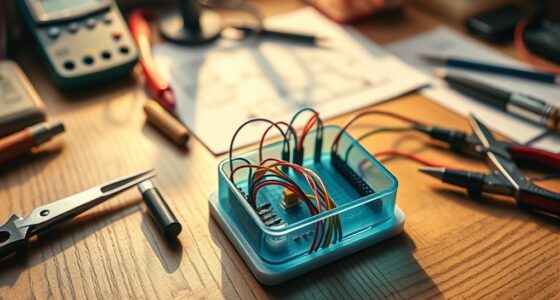To diagnose sulfation, check for voltage drops under load and perform capacity tests, as sulfation causes sluggish starts and reduced power. For stratification, measure specific gravity at different levels of the electrolyte; inconsistent readings indicate uneven electrolyte distribution. Keep an eye out for uneven charging or gassing, which signals internal issues. If you want to uncover effective methods to identify and fix these problems, there’s more you should explore now.
Key Takeaways
- Use a hydrometer to measure specific gravity at multiple battery points to detect stratification.
- Significant variations in specific gravity readings indicate electrolyte imbalance or stratification.
- Voltage drops during load testing can reveal electrode sulfation impacting capacity.
- Signs like excessive gassing and uneven charging suggest internal sulfation or stratification.
- Performing controlled equalization charging redistributes electrolyte and reduces stratification effects.

Diagnosing lead-acid batteries is vital to guarantee they perform reliably and avoid unexpected failures. One common issue that affects battery health is electrode degradation, which occurs when the active material on the plates deteriorates over time. This deterioration reduces the battery’s capacity and can cause it to fail prematurely. When electrodes degrade, you might notice a drop in voltage or reduced run time, but these symptoms often go unnoticed until the problem becomes severe. To properly diagnose electrode degradation, you should regularly check the battery’s voltage and perform load tests. If the voltage drops markedly under load, it indicates that the electrodes might be compromised. Additionally, inspecting the plates visually for signs of corrosion or shedding can help identify physical deterioration early.
Another key factor to watch for is electrolyte imbalance, which is often caused by stratification or uneven distribution of the electrolyte within the cell. Electrolyte imbalance hampers chemical reactions necessary for efficient energy transfer, thereby reducing the battery’s overall performance. Stratification occurs when the electrolyte’s heavier components settle at the bottom, creating layers that hinder ion flow. This can be detected by measuring the specific gravity of the electrolyte at different levels within the cell; if the readings vary markedly, stratification is likely present. Regularly testing the electrolyte’s specific gravity can help you catch this issue early. If imbalance is suspected, gentle shaking or equalization charging can help redistribute the electrolyte and restore proper function. Additionally, understanding the impact of contrast ratio can help you evaluate the effectiveness of your diagnostic techniques in assessing the battery’s internal condition. Diagnosing these issues also involves paying attention to signs of electrolyte imbalance, such as inconsistent charging behavior, increased gassing, or a sudden drop in capacity. When electrolyte imbalance occurs, the battery may exhibit uneven charging or excessive heat during operation. Using a hydrometer to check the specific gravity at multiple points allows you to detect stratification, and consistent readings across the cell suggest a healthy electrolyte distribution. If you notice persistent problems, it may be necessary to perform a controlled equalization charge, which helps break down stratified layers and promotes uniform electrolyte distribution.
Frequently Asked Questions
Can Sulfation Be Reversed Without Replacing the Battery?
Yes, sulfation can often be reversed without replacing the battery. Proper battery maintenance, such as regular charging and discharging cycles, helps break down lead sulfate crystals. Conducting electrolyte analysis can identify sulfation levels, guiding you on appropriate recovery methods. Using desulfation techniques, like applying a specialized charger or electrochemical treatment, can restore battery capacity and extend its life without the need for replacement.
How Does Stratification Affect Battery Lifespan?
Have you ever wondered how stratification shortens your battery’s life? It happens when electrolyte mixing doesn’t occur properly, causing the heavier acid to settle at the bottom. This uneven distribution leads to uneven battery cycling, increasing wear and reducing capacity over time. To extend your battery’s lifespan, guarantee regular charging and maintenance, promoting proper electrolyte mixing and preventing stratification from damaging your lead‑acid battery.
Are There Specific Signs Indicating Stratification?
Yes, there are signs indicating stratification. You’ll notice electrolyte layering, where the acid settles unevenly, creating distinct layers. This causes capacity reduction because the electrolyte isn’t evenly distributed, affecting battery performance. You might also see inconsistent voltage readings and reduced run time. If you observe electrolyte separation or uneven acid levels, it’s a clear sign that stratification is occurring, and your battery needs attention.
What Tools Are Best for Early Sulfation Detection?
An ounce of prevention is worth a pound of cure. To detect early sulfation, you should use tools like electrolyte analysis kits that measure specific gravity and acidity levels. Regular battery maintenance with these tools helps identify subtle changes before performance drops. Keep an eye out for increased internal resistance and decreased capacity, which also signal sulfation onset. Early detection saves time, money, and extends your battery’s life.
How Often Should Batteries Be Tested for Stratification?
You should test your batteries for stratification at least every three to six months as part of regular battery maintenance. Increased testing frequency is advisable if your batteries are heavily used or show signs of uneven performance. Regular testing guarantees you catch stratification early, preventing capacity loss and extending battery life. Keep an eye on electrolyte levels and consistency, and adjust your testing schedule based on your operational demands.
Conclusion
Understanding sulfation and stratification is essential for diagnosing lead-acid batteries effectively. Did you know that over 60% of battery failures are due to these issues? By regularly checking your battery’s voltage and specific gravity, you can catch problems early and extend its lifespan. Don’t wait for a sudden failure—stay proactive. Proper diagnosis not only saves you money but also guarantees your equipment keeps running smoothly longer.










